Driver’s view: Andrew Lawman’s Pottinger Novacat A10 mowers
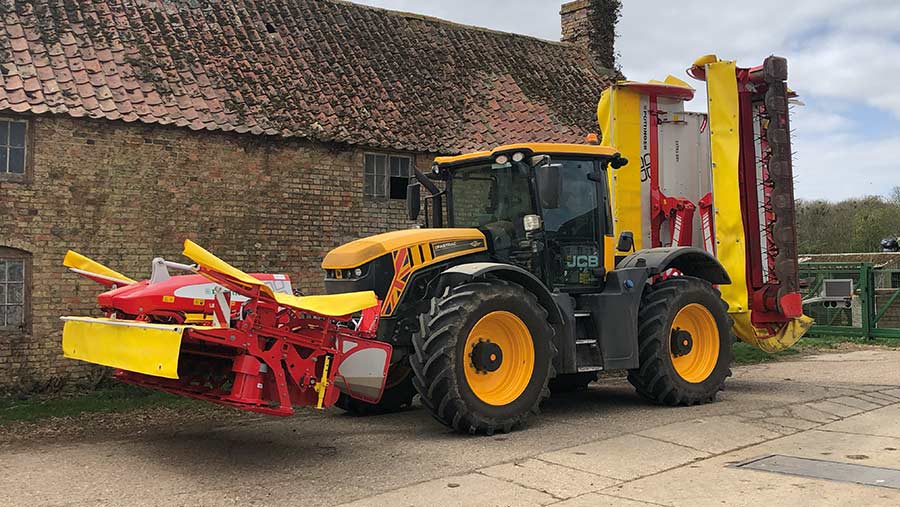 © MAG/Oliver Mark
© MAG/Oliver Mark Cambridgeshire farmer Andrew Lawman gives us his verdict on his Pottinger triple mo-cos mower.
Business facts – Graham Lawman, Cambridgeshire
- Cropping 400ha rented grass for wrapped silage, haylage for horses and hay for pet food; 30ha lucerne; 240ha in-hand arable
- Other work 4,000ha straw baling, 800ha grass harvesting
- Livestock 120-head suckler herd, plus 230-head youngstock
See also: On test: JCB Fastrac 4220
What made you choose Pottinger mowers?
We decided to upgrade our four-year-old front-and-rear Pottinger combination in 2017, so had one of the first sets of A10 butterflies to come off the production line.
We paired them with our original front mower, which we kept until 2020. I’ve always liked Pottinger mowers because they’re strong and heavy without being unwieldy.
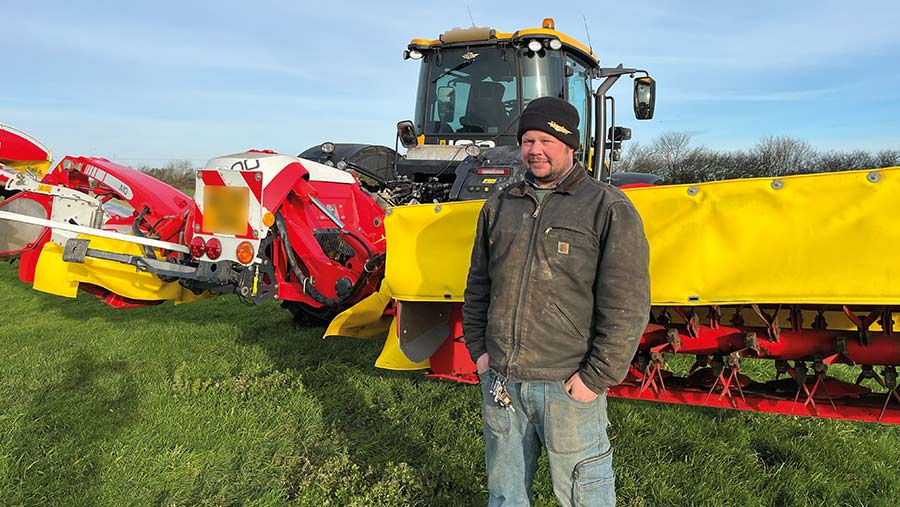
Andrew Lawman © MAG/Oliver Mark
The steel is braced in all the right places and they’re tough enough to be pushed as hard as the tractor can handle.
The main reason for the switch to triples was to improve the timeliness of cuts, rather than increase our overall output.
We’re making decent quality hay for pet food and haylage for horses, so I want to be able to knock down 15ha in the afternoon when the sugar content is high.
I rarely do a full day’s mowing, and we don’t have the harvesting machinery to keep up with a set of triples at full bore, but it gives me the flexibility to work it around other jobs.
The other appeal of triples over a front and offset rear combination is balance.
The tractor’s rear right wheel used to dig in and make a mess when it was wet, but weight distribution is now much better.
I also have the benefit of JCB’s hydro-pneumatic self-levelling suspension on the Fastrac, which eliminates the bounce that you would get with conventional tractors.
What tractor are they run on?
We’re currently on a 20-plate JCB Fastrac 4220. It’s just about big enough, but it would struggle to keep ahead of a self-propelled forager in heavy crops and on hilly ground.
As a result, I tend to be pushing it to its limit, averaging up to 14ha/hour with diesel consumption running just over 40 litres/hour. A bigger tractor would probably be more frugal.
The upsides of the Fastrac are its four-wheel steer, which makes it much easier to cut the headlands, and the fact it’s so much quicker and safer on the road.
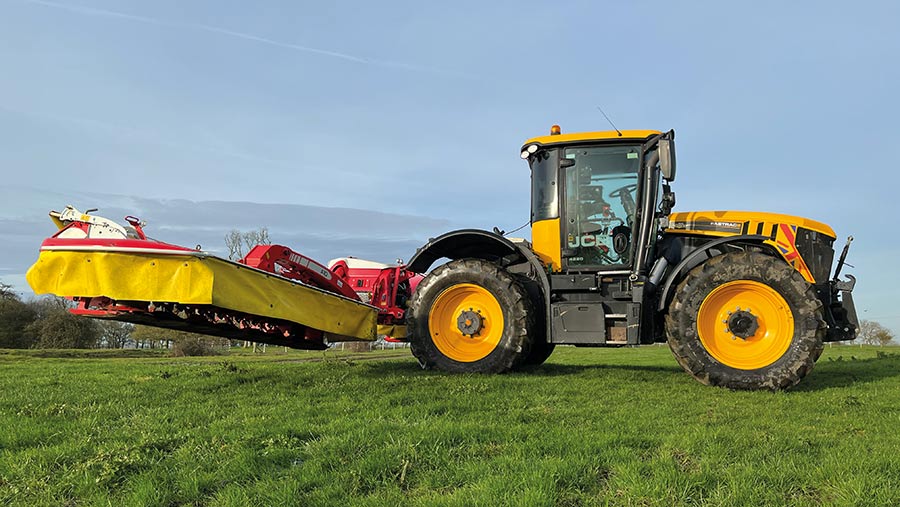
The Fastrac 4220 is just about powerful enough to run the 9.5m triples on relatively flat ground © MAG/Oliver Mark
GPS guidance is essential, though. As our butterfly has the 3m headstock and we run a 3m-wide front mower, there’s zero margin for error when they’re shoved out for the full 9.5m working width.
I have to telescope them in for any curves, which gives me a maximum of 40cm overlap on each side.
I could make life easier in the field by having Pottinger’s 3.5m front mower, but I wouldn’t get into half the fields with it – as it is, there is often a finger’s width between the mower and gate posts.
I run autosteer on Trimble’s RangePoint – I tried Egnos, which was fine on a single run but didn’t have the repeatability, so I found myself constantly having to reset the AB line.
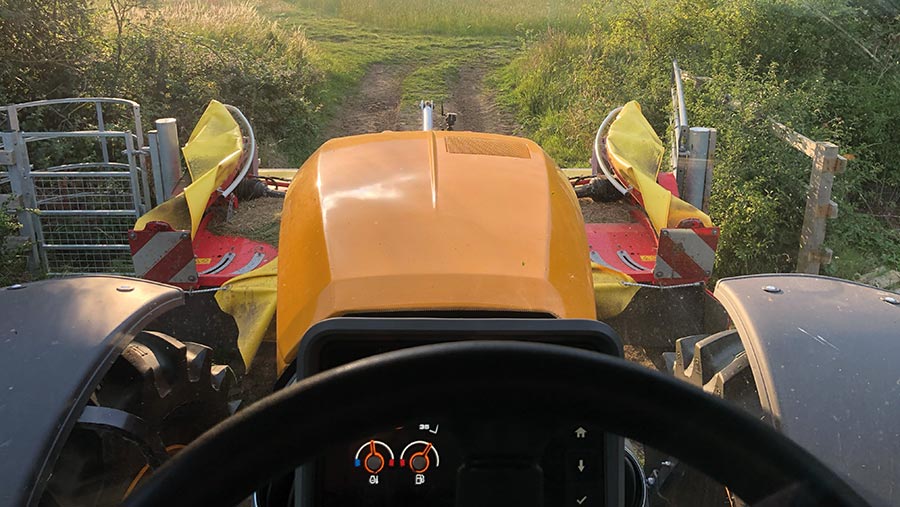
Tight gateways meant Andrew Lawman had to opt for a 3m front mower © MAG/Oliver Mark
As for controls, I tend to set it up on the Fastrac’s headland management system, which means I just press the “play” button on the joystick.
I also have the standard Pottinger control box, as I’m a bit wary of Isobus – in my experience, it’s slow, clunky and the interface adds complexity that can end up causing problems.
Pottinger Novacat A10 ED butterfly*
*Paired with 301 Pro ED front
- Working width (with 3m headstock) 8.8-9.46m
- Telescopic adjustment 40cm each side
- Discs Eight each side
- Conditioners “ED” steel tines
- Transport height and width 4×2.7m
- Weight 3,080kg rear; 885kg front
- Power requirement 180hp rear; 60hp front
- Swath width 2.2-3.1m
- List price £57,854 rear; £20,145 front
How has it performed?
I have very few complaints. One of the best things about the design is that the skids reach ahead of the discs so, if I hit something, the discs can keep spinning and the blades swivel out of the way.
I once hit a hidden concrete water trough at 20kph, and the only damage was four quick-change blades worth little more than a fiver.
The only major breakdown was a gearbox bearing failure last season. I decided to swap the whole gearbox, which cost well into four figures.
I could have replaced just the bearing, but I wasn’t sure about the condition of the sprockets and teeth, so decided to play it safe.
The driveline itself is a little more complicated than usual because the two dropboxes come out the opposite side of the gearbox to the beds that they drive.
The advantage is that there is space for longer pto shafts, which allows for a bigger side-shift and means they run at a shallower angle.
We run a steel tine conditioner, which has lasted well. I’ve not yet had to replace any tines because of wear, despite hitting fence posts, concrete blocks and everything inbetween, as it’s usually the rubber blocks they push against that give out.
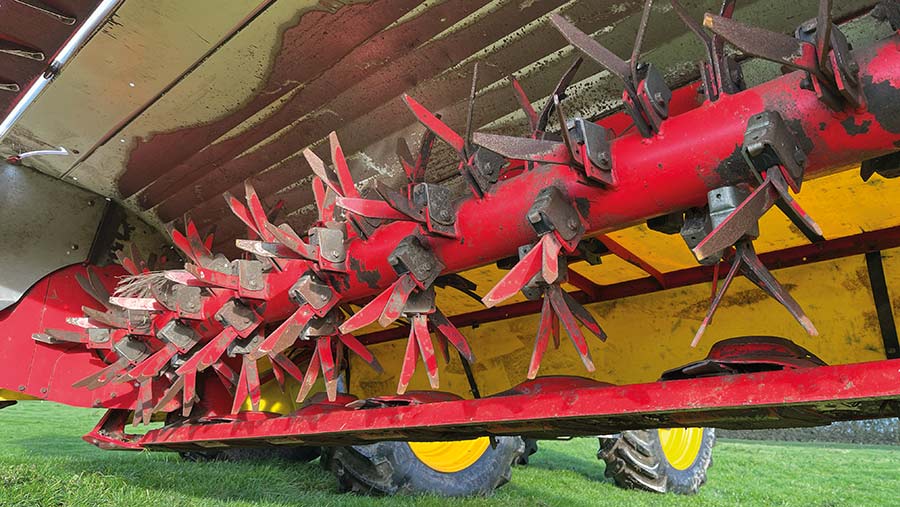
Rubber blocks on the conditioner mounting brackets tend to need replacing more frequently than the tines © MAG/Oliver Mark
What could be improved?
Most of my gripes are pretty minor – it’s too easy to overtighten and shear off the wing bolts and front guard bolts when I’m not paying attention, and the spring-loaded latch that holds the front guards up can get full of sugary residue that prevents it clicking into position.
I also had my doubts about the stalks that hold the rear lights. They look precarious when they’re wobbling around all day, but they’ve now done five seasons without falling off.
One thing I would change is the manual end guards. They can be lifted and lowered hydraulically on the new front mower, and it has made me realise what a faff it is constantly getting in and out when I’m chomping through two-acre horse fields.
The thing I like about Pottinger is that the engineers listen to customer feedback. I once moaned about the conditioner hood fatiguing and cracking, so they added extra bracing to the newer models.
Would you have another?
Yes, I looked at replacing them this year, but ended up buying a 17m, 16-rotor tedder instead. The backup from Harrison Tractors at March has been brilliant, and we’re only 25 minutes from Pottinger’s headquarters at Corby.
I’ve also toyed with buying Pottinger’s RCB roller conditioner for the lucerne, as it would be possible to swap between the two conditioners in less than half an hour.
It would certainly be gentler on the crop, but we currently do four cuts a year across 30ha, which isn’t really enough to justify it.

